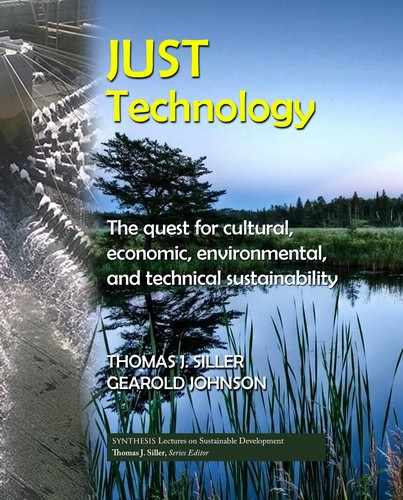20 3. SUSTAINABILITY
McDonough and Braungart, is that it is unnecessary to ask people to give up a better world for
the sake of sustainability—we can continue to have a world of abundance. eir philosophy is
captured by the following quote:
“When seen through the lens of technology, few resources are truly scarce; they’re mainly
inaccessible. Yet the threat of scarcity still dominates our worldview.”
ese authors are firmly in the “technology is the answer” camp for solving existing and
future problems. Early examples in the book include the plentiful source of water in the oceans
that just require new technology to efficiently desalinate it to make it potable, or the overabun-
dance of solar energy that needs technology break through to capture it for human use. What
the authors seem to ignore is the nonrenewable aspect of some of these natural resources. e
tension between scarcity and abundance or reduction of use vs. abundance may be at the heart
of the sustainability issue. Even Starke et al., who believe sustainable development is not real-
istic at the moment, admit that “While sustainability advocates may work to enfranchise future
generations and other species, we have little choice but to give priority to the needs of human
beings alive today while trying to preserve conditions that allow future generations to meet their
needs.” So with their book on abundance Diamandis and Kotler speak for abundance for today
while still claiming we are capable to preserve resources for future generations. eirs is a plan
that prioritizes the present generation as recommended by Starke et. al. is might seem then
to be an easier approach to sell to people today, but the pessimists we will discuss next would
indicate that this focus on abundance is flawed.
3.3 PESSIMISTIC VIEW
Just as there are those who are convinced we can develop sustainable approaches to solving some
of the serious issues faced by society today, there are others (including on of us) who claim it is
too late and sustainability is no longer viable. Whether the issue is developing sources of energy
or the increase in green-house gases leading to climate change, many predictions indicate we
have so big a problem we must start addressing it in aggressive manners—not likely sustainable.
At the end of this section we will look into one of the largest-scale approaches being suggested—
geo-engineering, or engineering the entire planet and atmosphere. But before going to that class
of approach let’s first try to understand why some people are so pessimistic.
In terms of sustainable energy, one critic is Ozzie Zehner, the author of Green Illusions:
e Dirty Secrets of Clean Energy and the Future of Environmentalism, [36] along with a webite:
http://criticalenvironmentalism.org. Zehner takes on what he calls the myths of clean
energy, including: solar cells, wind power, biofuels, nuclear, hydrogen power, clean coal, and
hydropower. For each energy source he points out the “hidden” costs for each energy source. For
example, with solar power he points out many issues that reduce the benefits of solar voltaic cells.
e price of the installations is one major concern. As he points out: prices have not dropped as
expected because the big costs that remain are the low-tech installation costs, not the costs of the
..................Content has been hidden....................
You can't read the all page of ebook, please click here login for view all page.
